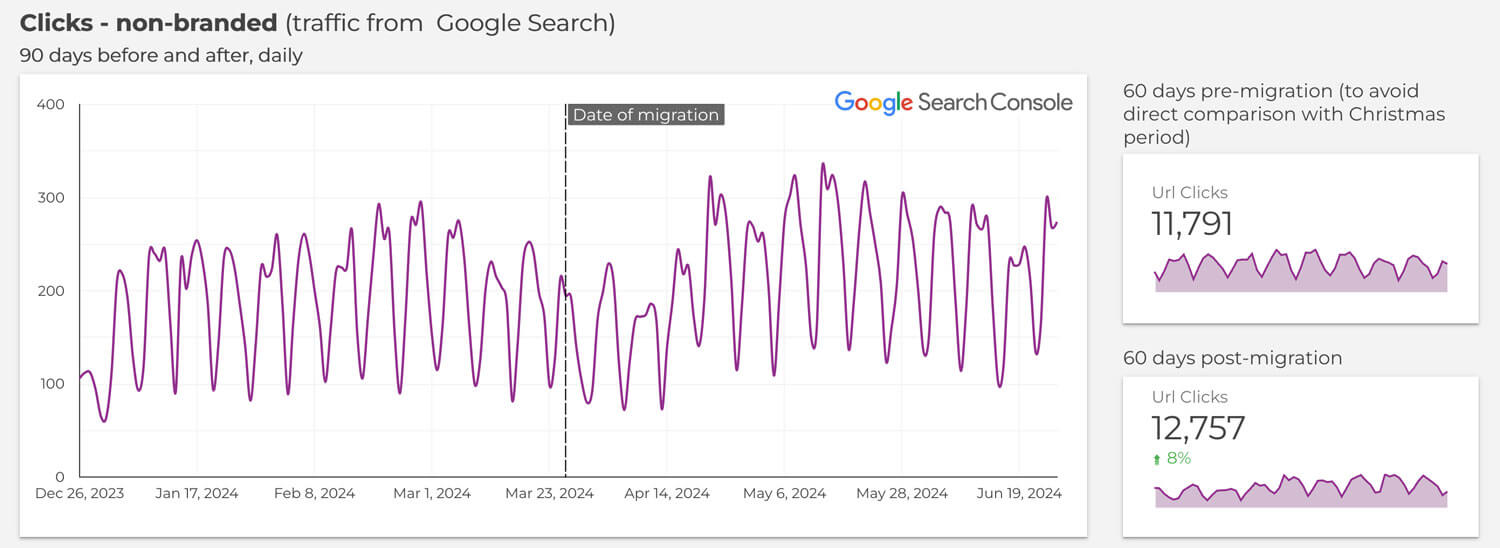SEO Website Migration Services
The best kind of website migration is the one that no one sees.

How Our Clients Did Last Month
Month-over-month traffic trends. Source: Google Search Console
Complete Your SEO Migration Without the Risk
SEO website migrations cover a lot of ground, but no matter what the scenario, Geeky Tech has helped our customers through them all without losing their organic traffic.
Our SaaS SEO migration services cover:
- Merging a new business into the main site
- Business and domain name changes
- Major content changes
Why Work With an SEO Migration Specialist?
A bad SEO site migration can cause a lot of problems for your rankings and traffic. Poor planning, a disregard for SEO best practices, and bad communication can all contribute towards plummeting visibility.
Here are the possible outcomes of migrating your site without consulting with an agency first:
If 301s aren’t properly set up, users and search engines may encounter 404 errors, which is the Mac user’s equivalent of the beach ball of death or the Xbox user’s red ring of death. In other words, it’s just a dead end.
Incorrect handling of URLs or content can lead to a drop in search engine rankings, which of course contributes to a significant drop in visibility and traffic.
Poor planning can result in key pages or assets not being migrated, causing gaps in content.
Incomplete migration of analytics and tracking codes can lead to data loss. While this doesn’t have an impact on your actual traffic, it does affect your ability to make data-driven marketing choices.
These problems can significantly impact user experience, traffic, and overall site performance, but hiring a website migration SEO agency as early as possible can help prevent major traffic issues down the road.
How We Maintain Your SEO Performance
An SEO domain migration doesn’t happen by flipping a ludicrously huge switch and hoping not to set off a smoke detector. It requires extensive planning, cooperation, and open communication between everyone involved.
Our migrations happen in two major phases:
At the pre-migration phase, we take all the necessary measures to understand what exactly your site needs, what problems may arise, and what a successful migration looks like.
We enter the post-migration phase as soon as the site goes live and any time after that. During this phase, we implement our website migration plan mapped out in the pre-migration phase, and we closely monitor and report the results.
Our Pre-Migration SEO Services
Before anything happens, we conduct a pre-migration as part of our SEO migration best practices.
Planning
Migration Overview & Planning
Geeky Tech’s SEO migration process starts with a migration overview call that includes you, our technical SEO team, and any other third parties involved. We do this as early as possible before too many decisions have been made.
Our main goal is to understand the whole situation, the various platforms involved, desired timeframes, and any concerns your marketing team has. We’ll also ask you about any platforms you rely on at this time.
Mapping
Pre-Migration URL Mapping
Weathering the storm of your major website changes so no organic traffic is lost is what we’re aiming for.
We prioritise pages in order of traffic volume to help us understand what can be safely culled or edited, and what should be left untouched. We end up with a list of pages and how many clicks they’ve received, a crucial document that will help during the post-migration phase.
Documentation
Third-Party Script Documentation
Third-party scripts don’t need to make your migration a nightmare. We always make a point of documenting Google Tag Manager, Google Search Console and Google Analytics scripts since our SEO strategy relies heavily on them, but will include anything else you’ve requested or anything else that we find.

Our Post-Migration Services
A migration is one of the most stressful days of a marketing manager’s life—it’s up there with moving house and getting divorced. So we hope our migration plan will move it a little further down the list of things to worry about!
Launch
Launch Day Monitoring & SEO Audit
On launch day, our SEO team will check that your scripts are all alive and kicking on the revamped website; that the site hasn’t been set to noindex by accident; and that you’ve changed your address with Google Search Console.
At this stage, if your migration scenario involves a new website, our technical team will also perform a website audit to make sure everything is firing as it should.
Checks
Post-migration URL checks
We now check your list of ranking pages to find out if they still exist, or if they’ve been redirected, or are now dead pages (404s).
We want to make sure that 301s are correctly configured and that 404s are redirected to a relevant page.
Reporting
Reporting Setup
Transparency is one of our founding principles. We want to make sure you have full access to your migration data without having to sift through data you don’t understand, or are just left in the dark.
To wit, we’ll create a dashboard with a dedicated migration page to show you a timeline of your website, from 90 days pre-migration to 90 days post-migration. We get really granular with the data, so you can track the progress on a daily level to see the details that matter.
We work with a tried and tested template but will always add or remove items and metrics to suit your migration and the metrics you’re most interested in.

Checkups
Ongoing Migration Checkups & Reporting
You’ve gone live and all the tracking scripts and 301s are in place, but the work is far from done…at least for us.
We check your traffic, your rankings for fluctuations, and your new sitemap (presuming it’s new) for its indexation rate. We do this at week two, then at 30, 60 and 90 days.
We’ll send you an update at those 30-, 60- and 90-day milestones to let you know if any extra action is needed to maintain particular rankings. We’ll also issue you a 90-day report showing you the final results and a recap of the entire process.
Geeky Tech's Other SEO Services
We’re more than just an SEO migration dream team. Geeky Tech specialises in SEO and paid media for B2B technology and SaaS companies. Our award-winning seo web migration services are contract free and backed by a 30-day guarantee.
SEO
Search Engine Optimisation (SEO)
Our goal is to help your business achieve long-term ROI by increasing your search engine rankings and attracting more qualified leads. Every SEO service we do for our clients we do for ourselves:
- Full SEO audit
- Keyword research and strategy
- On-page optimisation
- Technical SEO
- SEO content
- Link-building
- Analytics and reporting
By ranking for relevant and high-commercial keywords, you can attract highly targeted leads who are actively searching for your products or services. And since optimised websites are often seen as more authoritative, SEO helps you boost credibility and trust with your audience.
Paid
Paid Media
We craft, manage, and optimise high-performance paid media campaigns that deliver immediate results.
Our paid media service includes:
- Comprehensive campaign management
- Keyword targeting
- Full-funnel strategy
- Flexible budget options
- PPC, Google Ads, social media
Paid media and PPC offer immediate visibility and targeted reach. By leveraging PPC campaigns, you can place your business in front of the decision-makers actively searching for your solutions—i.e., you can precisely target people who match your customer avatar down to the most relevant details.
This granular targeting ensures that your ads reach the right audience, which maximises lead generation and lowers costs. This strategic approach can boost brand awareness, drive qualified traffic, and accelerate the sales funnel.
What a Successful Website Migration Strategy Looks Like

The Challenge
- The in-house marketing team needed guidance to protect high-value rankings and non-branded traffic during the migration.
- A clear plan was necessary due to the involvement of two third-party agencies for SEO and web development.
- The migration process was complicated by a bloated Google Tag Manager container and a switch to a new consent management platform.
The Solution
- Conducted a pre-migration audit and prioritised pages with high traffic.
- Focused on implementing major changes gradually to allow troubleshooting if needed.
- Provided post-migration support at weeks 1 and 2, and months 1, 2, and 3 to ensure new pages were indexed, rankings were stable, and traffic remained steady.
- Delivered dedicated reports to demonstrate the migration's quantitative success.
The Results
- Successful SEO migration
- Retained all previous page 1 rankings
- Gained 4 new page 1 rankings
- An average increase of 11 positions across 16 target keywords
- 4% increase in organic clicks
- 8% rise in non-branded organic clicks.
Meet Your Migration Experts
Geeky Tech represents a team of top-tier SEO and paid advertising experts, each with a diverse set of skills. Our team operates globally, with members in the UK, Morocco, Turkey, Portugal, Serbia, South Africa, and France…and counting!
At Geeky Tech, our comprehensive SEO and PPC services are backed by nearly a century of combined experience. We use proprietary tools to help us speed up our research, and can demonstrate our proven results.
We offer a straightforward monthly fee with no hidden costs or contracts. Best of all, our team guarantees a transparent, no-nonsense approach to achieving your digital marketing goals. Read more about custom CMS SEO migration.

Website SEO Migration FAQs
Anything that significantly changes a website and can impact its visibility in search engine results would be considered an SEO migration.
Major changes include rebranding, URL restructuring, platform/CMS changes, or content overhauls. The goal of a proper SEO migration is to preserve or improve search engine rankings and organic traffic during and after the transition.
With so many cooks in the kitchen, understanding who is responsible for what becomes a matter of great importance. In our experience, the key players involved in a migration are the SEO website migration services agency (us), the marketing managers (you), and the developers they’ve hired to build a new website, for example.
We see ourselves as consultants in the process; We help both the marketing managers and developers understand any potential pitfalls, and act as another set of eyes across the whole process to give everyone peace of mind.
URL mapping: Deciding where pages should be redirected is generally the marketing manager’s job, but we can assist or even do this for you. Customers tend to know their own website better than a third party, so this would ideally be your domain of influence. In this scenario, we would sense-check the decisions.
Redirects: Typically this is the developer’s job, since they’ll have access to the development environment (we keep out until the new site is live) and they can implement the redirects early. We then check right after go-live and make edits if required. We can do this part of the migration, but it would likely be the slower option.
From an SEO perspective, a migration is important because it ensures that significant changes to a website don’t negatively impact search engine rankings and organic traffic.
The old domain still needs to exist since this is where the original links live. If you delete the site or don’t continue to host it then the redirects disappear, which kind of defeats the whole purpose.
You’ll need to continue hosting the site and paying for the domain name for at least one year post migration to be on the safe side, so make sure this is factored into your budget.
- Overlooking critical aspects like URL mapping, content prioritisation, and timeline management.
- Ensuring smooth communication between SEO, marketing, and development teams.
- Leaving adequate time for thorough testing of the new site.
- Keeping an eye on the post-migration site long enough to track changes and make necessary adjustments.
In a nutshell, mapping old URLs to new URLs during an SEO migration goes as follows (but we don’t recommend doing this without the help from website migration seo services agency):
Step 1: Create a URL Inventory
List all old URLs from the existing site. This can be done using tools like Google Analytics and Google Search Console.
Step 2: Develop a Mapping Plan
Match each old URL to its corresponding new URL. This can be done based on content similarity, new site structure, or desired redirection path. Your SEO migration agency can help you.
Step 3: Implement 301s
Use 301s to permanently redirect old URLs to the new ones. This can be done via the .htaccess file (for Apache servers), server configurations, or a CMS plugin.
Step 4: Test 301s
Check that all rerouted links work correctly and lead to the intended new URLs. Tools like Screaming Frog can help verify this.
Step 5: Monitor Performance
After the migration, monitor the site’s traffic, rankings, and crawl errors to ensure the 301s are working as expected and make adjustments if necessary.
Only use the official ‘change of address’ in Google Search Console if the domain has changed. Otherwise, requesting a recrawl of your sitemap (which represents your new URLs and content) is enough.